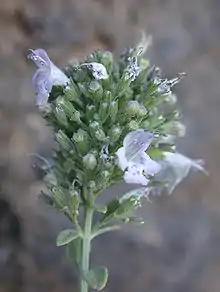Micromeria fruticosa
Micromeria fruticosa, commonly known as white micromeria or white-leaved savory, is a dwarf evergreen shrub endemic to Palestine and Israel and the eastern Mediterranean.[1] It is a member of the genus Micromeria, in the family Lamiaceae. It is known as zuta levana (זוטה לבנה or זוטא לבנה) in today's Modern Hebrew and ashab a-shai (عشب الشاي) in Arabic.[2]
| Wikimedia Commons has media related to Clinopodium serpyllifolium. |
| Micromeria fruticosa | |
|---|---|
 | |
| Scientific classification | |
| Kingdom: | Plantae |
| Clade: | Tracheophytes |
| Clade: | Angiosperms |
| Clade: | Eudicots |
| Clade: | Asterids |
| Order: | Lamiales |
| Family: | Lamiaceae |
| Genus: | Micromeria |
| Species: | M. fruticosa |
| Binomial name | |
| Micromeria fruticosa Druce | |
The Bedouins of Israel, however, call it by the Arabic name, qurniyya (Arabic: القورنِيه), believed to be a cognate of the Hebrew qoranit, an aromatic herb described in the Mishnah.[3] The plant's aromatic leaves (resembling mint) are used in making decoctions (herbal teas).
White-leaved savory grows mainly on rock surfaces in the low Mediterranean region, and is more common on chalk and calcrete rocks than on rocks of limestone.[4] In the Levant its white blossoms can be seen between July to November.
Taxonomy & nomenclature
.jpg.webp)
Plant properties
The plant, which contains a high concentration of the monoterpene essential oil known as pulegone, as well as isomenthol, is known for its medicinal properties. In folk remedies, it has been used in treating ailments such as abdominal pains, diarrhoea, eye infections, heart disorders, high blood pressure, weariness, exhaustion, colds and open wounds.[5] Other usages include making a poultice from the boiled leaves and applying it onto burns and skin infections, or drinking an infusion from its leaves for relieving stomach aches, or gargling with the same for treating bad breath odors and gum infections.[6]
References
- Dudai et al. Developmental Control of Monoterpene Content and Composition in Micromeria fruticosa(L.) Druce, Annals of Botany, Volume 88, Number 3, Pp. 349-354, Oxford Journals
- Micromeria fruticosa, Wildflowers of Israel
- See p. 149 in: Witztum, Allan (1992). "Hebrew, Aramaic and Arabic Names for Plants in the Mint Family". Lĕšonénu: A Journal for the Study of the Hebrew Language and Cognate Subjects: 147–151. JSTOR 24345785. (Hebrew)
- Avi Shmida, MAPA's Dictionary of Plants and Flowers in Israel, Tel Aviv 2005, p. 48 (s.v. Micromeria fruticosa) (in Hebrew) OCLC 716569354
- Dudai, Larkov, Ravid, Putievsky and Lewinsohn, Developmental Control of Monoterpene Content and Composition in Micromeria fruticosa (L.) Druce, Annals of Botany, Volume 88, Number 3, Oxford 2001, p. 349
- Nissim Krispil, Medicinal Plants in Israel and Throughout the World - the Complete Guide, Or Yehuda (Israel) 2000, p. 92